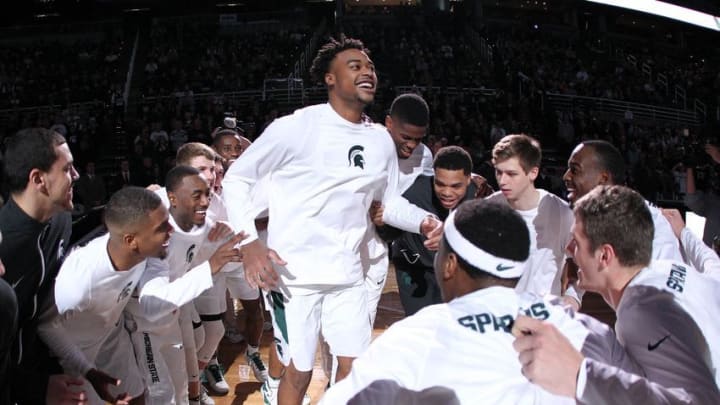Michigan State basketball has been far from consistent, but has found a surprising freshman to lead the way en route to the top of the Big Ten standings.
There isn’t one firm answer to why Michigan State basketball has been so up and down this season. A lot have pointed to the freshmen and their general inconsistencies, which are true, but this is also something that plagues most programs and athletes in general.
Must Read: MSU Recruiting: 10 ideal football targets to land by National Signing Day
Is North Carolina 51 points better than NC State? Is IPFW better than Indiana? If Clemson is the best football team in the country, then why could they barely beat Troy and lose to Pittsburgh?
This all leads to: How did Michigan State go from looking outmatched against Penn State to destroying what was one of the more consistent teams in the Big Ten, Minnesota?
The difference between those two games is evident. Penn State, not known for being a good shooting team, went 21-of-37 on shots inside the arc. To make matters worse, PSU’s leading scorer, Shep Garner, was just 2-of-8 with eight points and had the worst offensive rating of any of the starters.
The Minnesota game was close to the opposite as the Gophers scored their fewest points all season at 47, shooting a miserable 33.3 percent from the field. The funny thing is that Michigan State’s defense is good. In fact, they lead a number of lists in the Big Ten, starting with defensive efficiency and effective field goal percentage allowed.
If MSU’s defense shows up, they can usually take care of good-to-mediocre teams. But this is all obvious. If a team plays good defense, holding its opponent to below 40 percent shooting, it’ll more often than not, win.
But diving into the numbers, there is something else that correlates to Michigan State’s success and it’s not about having good defense (although slightly relatable). It has to do with Nick Ward’s usage rate… and it makes sense. Ward leads the nation in fouls drawn per 40 minutes (almost 10) and has the best block percentage in the Big Ten. Basically, when he’s in the game, he’s a major factor on both ends of the court.
Obviously, he only played 13 minutes in the win over Minnesota due to foul trouble, but with nine points and eight boards, he was still effective. And as it stands, Ward is the most consistent player on the team. Joshua Langford dropped 13 points on Wednesday after failing to surpass eight points in the previous six games. Miles Bridges is a difference maker, but rarely has he been so effective shooting (5-of-7 FG, 2-of-3 3pt, 4-of-4 FT). And of course, Kenny Goins won’t be averaging eight points and nine rebounds per game any time soon.
That’s where the consistency of Ward comes in, having an offensive rating of at least 86 every game this season. In comparison, Bridges was at 45 against Penn State and 35 against Kentucky. To explain offensive rating, it’s basically the number of points a player produces per 100 possessions. But for the matter at hand, usage rate may tell a better story (stats found at KenPom).
Ward’s usage rate (percentage of plays utilized by a player while in game) in five Big Ten games:
- 55% vs. Minnesota
- 26% at Penn State
- 27% vs. Rutgers
- 32% vs. Northwestern
- 33% at Minnesota
To explain those numbers, Ward was involved on more than every other possession against Minnesota, even in limited time. Yes, he was still used a lot against Penn State, but given that he played 29 minutes, that 26 percent usage ended up hurting the team. The last time Ward was used so little in a relatively close game was in November against Wichita State (wasn’t needed as much in blowout vs. Rutgers).
Maybe the defense of Penn State’s freshman Mike Watkins limited Ward’s overall efficiency in that loss, but everyone watching the game knows better. There was a point late in the game that Michigan State failed to pass the ball into the post on four or five straight possessions and those all resulted in turnovers and the shot clock winding down. Considering Ward only had one foul, getting the ball to him when he was in the game should’ve been a bigger strategy.
So while Penn State was strangely efficient offensively, the 17 turnovers by the Spartans were in part caused because they didn’t get the ball to Ward enough times, and that’s seen in the numbers.
Related Story: MSU Recruiting: 5 bold predictions for January
On the season, Ward’s 32.9 percent usage rate is almost seven percent more than any other player on the team. Against the Nittany Lions, that was far from the case. Going back to the Northeastern loss, Ward was used a lot (32 percent), but those numbers don’t mean anything when Kenny Goins and Matt McQuaid see the court as much as him.
Sure, a lot of MSU’s success depends on effort and mindset going into these games, but one thing is certain for the Spartans going forward: they can only go as far as Nick Ward takes them.
